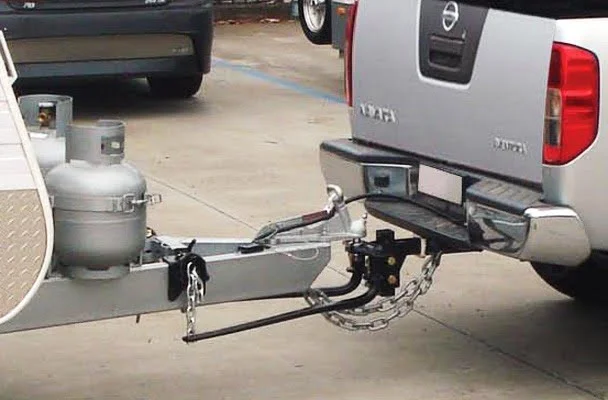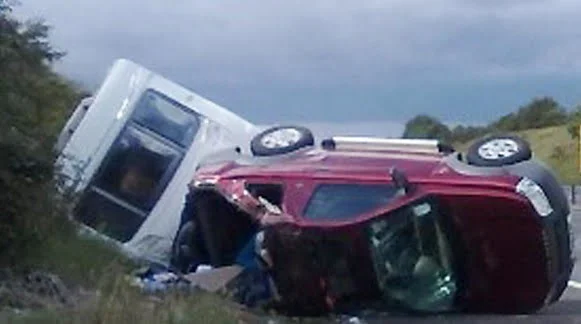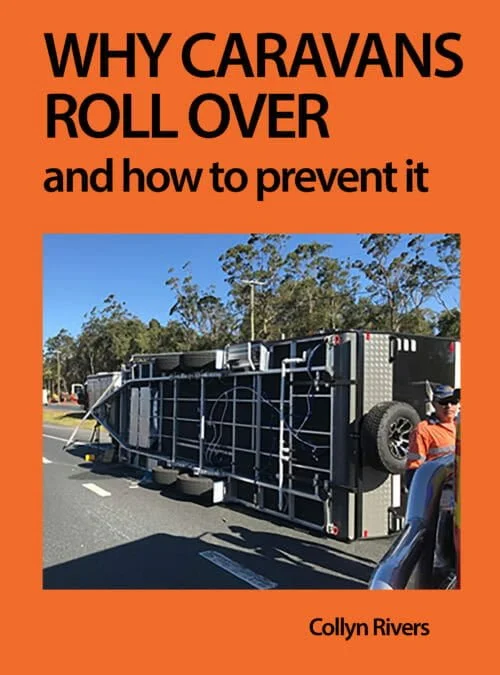by Collyn Rivers
Weight Distribution Hitch Setup
Correct weight distribution hitch setup compensates travel trailer tow vehicle front end lift. It introduces instability, however, if set too tight. Here’s why.

Typical WDH (weight distributing hitch) Pic: Jayco.
Conventional travel trailers are towed via a hitch that overhangs the tow vehicle’s rear axle. If that travel trailer sways, it causes the tow vehicle also to sway (and vice versa). This effect is reduced by having the travel trailer nose-heavy.
For travel trailers with centralised mass and loading, ‘the improvement becomes less significant when the nose mass rises above 6-7 per cent of the total weight’, says University of Bath’s Professor Josh Darling¹. Australian travel trailers, however, are typically 40% or so heavier (per metre) than almost all UK/EU products. Our long and heavy travel trailers need 10%. Imposing such heavy tow ball mass on that overhung hitch, however, causes the rear of the tow vehicle to drop as the rear springs compress. It also levers up the front of the tow vehicle.
To address this issue, a separate industry developed weight distribution hitches. But these act much like a truss to support a hernia. It is better by far to eliminate the need for such devices. Or, at least to limit their weight correction.
Weight distribution hitch setup
A WDH (in effect) is a springy semi-flexible beam between the travel trailer and its tow vehicle. It levers back up the tow vehicle’s rear tyres – and its front wheels back down.
A common and seriously-misleading RVers Forum recommendation is to adjust a WDH to fully counteract the travel trailer‘s nose ball weight. Doing so, however, reduces the weight on the tow vehicle’s rear tyres. This reduces their ‘cornering power’. A WDH cannot decrease the travel trailer‘s still existing sideways yawing forces. Worse, however, is that the WDH has now reduced their ability to resist those forces. If the tow vehicle’s rear tyres exceed a critical level (typically of 8 degrees) they suddenly lose all grip. If that happens the rig will (irreversibly) jack-knife.
This is a situation that, no matter how skilled, the driver cannot correct. This is because the sway sequence is random-like, so the driver cannot forecast the correction required. In this situation, the best the driver can do is to hold the central and, if possible, apply the travel trailer only. Never the tow vehicle brakes. The commonly-given advise, to accelerate, is inherently dangerous. It works well at low speed – but may cause the rig to reach a ‘critical speed’ where the rig is likely to jack-knife.

The beginning of a travel trailer jack-knife. Pic: copyright – rvbooks.com.au
Do not attempt to level the rig
A WDH reduces the tow vehicle’s desirable margin of under-steer – i.e. it causes it to be less stable directionally. It also reduces its cornering ability by 25% plus (see also below). Because of this, tightening a WDH to fully correct the effect of tow ball mass is seriously counterproductive. Never adjust the travel trailer and tow vehicle such they are totally level.
To adjust a WDH, adjust the lowered jockey wheel until the travel trailer is level. Now measure (and note) the front of the travel trailer chassis’s height from the ground. Then, with the tow vehicle laden and the equivalent weight of driver and passengers on board, lower the travel trailer onto the tow ball. Again measure the travel trailer‘s front chassis height from the ground. Adjust WDH bar spring tension so as to correct no more than 50% of that height difference.
Another way of adjusting is to measure the height of the tow vehicle’s front mudguard. When adjusted correctly, it increases that height by about 50 mm. This is likely to cause the front of the travel trailer to be about 50 mm lower than when level.
The SAE standard, ‘Performance Requirements for Determining Tow-Vehicle Gross Combination Weight Rating and Trailer Weight Rating’, (J2807) quantifies this. The standard used only 50% correction in its main WDH stability testing. It nevertheless found even that amount reduced the cornering ability by 25%. It was from 0.4 g to 0.3 g. A rough concept of such forces is that road authority posted recommended cornering speeds are usually set at about 0.2.
At one time, Hayman Reese in Australia recommended 100% correction. Chief Engineer (Rick McCoy) of its US parent (Cequent), however, has long recommended only 50% correction be used. The Australian company does not appear to use percentage terms, but its current recommendations seem now to accord with its parent company.
Correcting tow ball mass by 50% typically results in the travel trailer‘s nose being lower by about 50 mm.

Travel trailer jack-knife in the UK – Pic: original source unknown
Tyre pressures when towing
When towing, increase the tow vehicle’s rear tyre pressure and reduce the tow vehicle’s front tyre pressure to retain understeer.
One well-known paper² states: ‘Reduced front tyre pressures on the tow vehicle can return the combination vehicle to car-alone [desirable] understeer, thereby completely negating the understeer lost to hitch load, with or without load levelling’. Many travel trailer owners find it successful. I can only legally suggest (not recommend), that this be considered. The suggested increase is to raise tow vehicle rear tyre pressures by 50-70 kPa (7-10 psi). Never increase tow vehicle front tyre pressure.
Inflate travel trailer tyres to whatever tyre makers advise for the weight borne (many are hugely under-inflated). Stability is assisted by using Light Truck Tyres. These do necessarily carry more weight but have stiffer side-walls. Here too (for dual axle ‘vans) increase the rear pair of tyres by 35-45 kPa.
The EU approach
The above issue is well understood (and covered in associated articles on this website). It has long been recognised in the EU. There, few travel trailers have a need a WDH. With most, it is not even possible to fit one.
Weight distribution hitch setup – References
That a WDH introduces unexpected issues was originally noted by Richard Klein, Donald Johnston and Henry Szostak in 1978. The two main ones are SAE 780012 ‘Effects of Trailer Hookup Practices on Passenger Car Handling and Braking, and in 1981, ‘Development of Maximum Allowable Hitch Load Boundaries for Trailer Towing’.
Richard’s work strongly influenced the SAE J2807 Recommendations re FALR (Front Axle Load Restoration). Cequent (the world’s largest WDH maker) now recommends that a WDH only correct 50% FALR.
- 1. Klein, R, Johnston, D, Szostak, H. ‘Effects of Trailer Hookup Practices on Passenger Car Handling and Braking.’ Society of Automotive Engineers Inc. SAE 780012 March 1978.
- 2. Darling J., Tilley D., and Gao B., 2008. ‘An experimental investigation of car-trailer high-speed stability’, Dept of Mechanical Engineering, University of Bath, UK.
- See also https://rvbooks.com.au/reducing-caravan-sway/ also https://rvbooks.com.au/making-caravans-stable/
The general topic is covered (more technically and in-depth) in Travel trailer and tow vehicle dynamics.
See also the excellent: (UK) caravanchronicles.com/guides/understanding-the-dynamics-of-towing/
If you found this article of value, my books will prove even more so. They include Caravan & Motorhome Electrics, Solar That Really Works (for RVs), Solar Success (for home and property systems), and The Camper Trailer Book. The author’s Caravan & Motorhome Book covers every aspect of the subject matter. All our books are now available in eBook and paperback versions.
The author is an ex-General Motors research engineer with a particular, and now plus 60 years, interest and writing and publishing in this area. See About the author.




